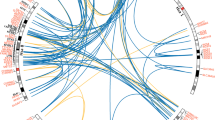Abstract
GATA genes are an evolutionarily conserved family, which encode a group of important transcription factors involved in the regulation of diverse processes including the development of the heart, haematopoietic system and sex gonads. However, the evolutionary history of the GATA family has not been completely understood. We constructed a complete phylogenetic tree with functional domain information of the GATA genes of both vertebrates and several invertebrates, and mapped the GATA genes onto relevant chromosomes. Conserved synteny was observed around the GATA loci on the chromosomes. GATAs have a tendency to segregate onto different chromosomes during evolution. The phylogenetic tree is consistent with the relevant functions of GATA members. Analysis of the zinc finger domain showed that the domain tends to be duplicated during evolution from invertebrates to vertebrates. We propose that the balance between duplications of zinc finger domains and GATA members should be maintained to exert their physiological roles in each evolutionary stage. Therefore, evolutionary pressure on the GATAs must exist to maintain the balance during evolution from invertebrates to vertebrates. These results reveal the evolutionary characteristics of the GATA family and contribute to a better understanding of the relationship between evolution and biological functions of the gene family, which will help to uncover the GATAs’ biological roles, evolution and their relationship with associated diseases.
Similar content being viewed by others
References
Evans T, Reitman M and Felsenfeld G 1988 An erythrocyte-specific DNA-binding factor recognizes a regulatory sequence common to all chicken globin genes; Proc. Natl. Acad. Sci. USA 85 5976–5980
Fossett N and Schulz R A 2001 Functional conservation of hematopoietic factors in Drosophila and vertebrates; Differentiation 69 83–90
Laverriere A C, MacNeill C, Mueller C, Poelmann R E, Burch J B and Evans T 1994 GATA-4/5/6, a subfamily of three transcription factors transcribed in developing heart and gut; J. Biol. Chem. 269 23177–23184
Lowry J A and Atchley W R 2000 Molecular evolution of the GATA family of transcription factors: conservation within the DNA-binding domain; J. Mol. Evol. 50 103–115
Newton A, Mackay J and Crossley M 2001 The N-terminal zinc finger of the erythroid transcription factor GATA-1 binds GATC motifs in DNA; J. Biol. Chem. 276 35794–35801
Patient R K and McGhee J D 2002 The GATA family (vertebrates and invertebrates); Curr. Opin. Genet. Dev. 12 416–422
Reyes J C, Muro-Pastor M I and Florencio F J 2004 The GATA family of transcription factors in Arabidopsis and rice; Plant Physiol. 134 1718–1732
Trainor C D, Ghirlando R and Simpson M A 2000 GATA zinc finger interactions modulate DNA binding and transactivation; J. Biol. Chem. 275 28157–28166
Yin F and Herring B P 2005 GATA-6 can act as a positive or negative regulator of smooth muscle-specific gene expression; J. Biol. Chem. 280 4745–4752
Author information
Authors and Affiliations
Corresponding authors
Rights and permissions
About this article
Cite this article
He, C., Cheng, H. & Zhou, R. GATA family of transcription factors of vertebrates: phylogenetics and chromosomal synteny. J. Biosci. 32 (Suppl 3), 1273–1280 (2007). https://doi.org/10.1007/s12038-007-0136-7
Received:
Accepted:
Published:
Issue Date:
DOI: https://doi.org/10.1007/s12038-007-0136-7




